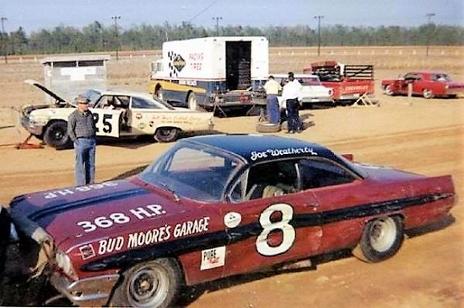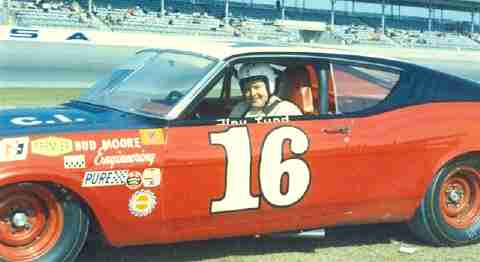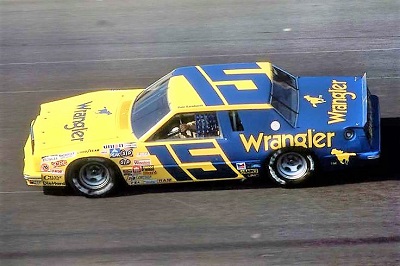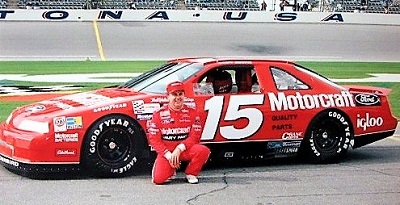

BUD MOORE - 5-25-1925 - 11-27-2017 -
a retired NASCAR car owner. He was born in Spartanburg, South Carolina. He was one of ten children, including six brothers and three sisters. After attending Jenkins and Cleveland Junior High, he started going to Spartanburg High School. After receiving his driver's license at the age of 14, he and friends Joe Eubanks and Cotton Owens raced their cars in the streets. He met his wife, Betty Clark, while in high school. The two dated until Moore departed for the military and got engaged prior to his service. On June 2, 1943, a day after graduating high school and a week after his 18th birthday, Moore was drafted into the United States military. Although he expressed interest in joining the Navy as Eubanks, Owens, and Moore's brother Charles were also in the branch, he did not have a college education (which was required for those entering the Navy) and a naval officer attempted to place him in the Marine Corps. Unhappy with this, Moore instead joined the Army as a machine gunner. On June 6, Moore's division landed on Utah Beach, where they faced German resistance and other obstacles; at one point, as he waded through the water, Moore stepped in a shell hole and fell in, causing him to go underwater before recovering. After
clearing the beach, Moore joined General George S. Patton at Périers, Manche. After leaving France, Moore's group crossed the Siegfried Line and reached the Rhine before being withdrawn to Verdun, where they stayed for three weeks without supplies. As it turned out, the Germans had built their infantry along the Siegfried Line and had launched the Battle of the Bulge, which forced Moore's division to fight their way back to the line and losing approximately 12,000 men in the process. On one mission during the battle, Moore and a German-speaking Jeep driver entered a German-occupied town that also served as a Wehrmacht area regimental headquarters. The two began to inspect houses and spotted a German soldier running into a wooden hut. Moore attacked the hut, causing it to catch fire and prompting the soldier to

Joe Weatherly 1961 Pontiac

Billy Wade 1964 Mercury
surrender; he was tied onto the hood of the Jeep. As they continued through the town, they noticed more Germans hiding in a rock house, which Moore also fired upon. Although the Germans displayed a white flag of surrender, they did not exit the building; Moore's driver ordered the captured soldier to convince his comrades to surrender before Moore summoned artillery. When they left the house, Moore discovered 15 soldiers and four officers among the surrendering German troops. He was awarded the Bronze Star Medal for his work in the operation. As he continued through Germany into Czechoslovakia, Moore was promoted to sergeant, during which he earned a second Bronze Star after his
involvement in a battle located in an abandoned hospital. He also received five Purple Hearts, four for shrapnel damage and one for taking machine gun fire to the hip. In spite of his injuries, he was often sent back into battle after brief stays in the hospital. In December 1944, he participated in the Siege of Bastogne, providing support for the besieged 101st Airborne Division. Despite the victory in Europe, Moore wondered about the possibility of fighting in the Pacific War against Japan. To return troops home, the government instituted a points system in which the most decorated troops leaving first. With his medals and service time of nine months and fourteen days without a break, he was among the first to return to the United States. When

Tiny Lund 1969

Buddy Baker 1974
Moore returned, he married Betty and had three sons, Greg, Daryl and Brent. A decorated veteran of World War II, he described himself as "an old country mechanic who loved to make 'em run fast". His cars were usually numbered 15 and often painted red and white and sponsored by Motorcraft. 1961 was the first year Moore got into NASCAR as a car owner. He fielded cars for five different drivers including Joe Weatherly who only started 23 races, but claimed eight wins in those events, and finished fourth in points. In 1962 and 1963 Weatherly would drive full time and chase the points championship. He would go on to win 12 races during those years, and
claim the Cup title. Those would be the only two years Moore fielded a full time race effort. In 1964 with Moore and Weatherly looking to win a third title, Weatherly would be killed in a race crash at Riverside Speedway road course. Moore would field cars for five additional drivers in 1964, with Billy Wade winning four times and Darel Dieringer winning once. Wade posted 23 top ten finishes and finished fourth in the points. Wade was killed while

Bobby Allison 1978

Benny Parsons 1981
testing at Daytona in 1965. Upon impact, Wade, who was strapped in securely, slid down and forward, causing his belts to crush him just below the rib cage. Car owner Bud Moore was devastated and sought a solution. That was the beginning of the “jockey strap,” often now termed the submarine belt. Moore would only have two drivers in 1965, and Dieringer drove 13 races and Earl Balmer drove nine. Darel would win once. Dieringer would be the only driver for Moore in 1966 as he drove 14 races, but won twice. Moore had five different drivers in 1967, all stars in their own right. He supplied cars for Bobby Allison, Gordon Johncock, Sam McQuagg, Cale Yarborough, and Lee Roy Yarbrough. None of them managed to find victory lane,
and in fact they only posted three top five finishes. Tiny Lund would wheel a Bud Moore car for 13 races, and finish in the top five three events in 1968; and Moore only entered one race in 1969. For 1970 and 1971 Moore would be on the sidelines as he did not race a car at all, but in 1972 he was back. Donnie Allison, Dick Brooks, David Pearson, and Yarbrough would drive at least one race each for Moore, with only Pearson finishing in the top five. 1973 and 1974 saw two drivers behind the wheel of Moore's cars. Bobby Isaac drove in five events, while up-start Darrell Waltrip ran five races in his Terminal Transport Mercury in 1973. 1974 Moore had Buddy Baker and George Follmer drive a total of 27 races; together they posted 12 top five finishes. In 1975 Moore decided to concentrate all their efforts in a one car operation; and he

Dale Earnhardt 1983

Brett Bodine 1988
hired Buddy Baker as driver. Even though Baker only ran 23 races that season, he managed to post four wins, and 12 top five finishes. The following season Baker and Moore ran full time. Baker only won once, but finished seventh in points. The next season he went win-less, but improved to fifth in the championship standings. due to their lack of success Baker was replaced by Bobby Allison for the 1978 season, and Allison won five times and posted 22 top tens in 30 events. 1979 saw more of the same for the duo as
Allison once again claimed five wins, and 22 top ten finishes, this time finishing third in points. For 1980 the team had continued success with Allison getting four additional wins, but falling to sixth in the points. Allison was lured away from Moore in 1981 by Harry Ranier; he was replaced by Benny Parsons. He was only there one year, but won three times. 1982-1983 saw Dale Earnhardt Sr come to wheel the Wrangler Ford for Moore. Earnhardt had one win in his first season with Moore, and followed that up with two more the following year. Earnhardt would leave to drive for Richard Childress Racing in 1984, and Rick Rudd took his turn behind the wheel. The pairing

Geoff Bodine 1992

Lake Speed 1994
lasted four seasons with Rudd getting at least one win each year, and finish seventh or better in the points each year. Ricky Rudd would leave Moore to go and drive for Kenny Bernstein in 1988. Brett Bodine was he replacement, but over the next two seasons he would only have three top five finishes. He was replaced by Morgan shepherd in 1990 who grabbed a win at Atlanta, and finished fifth in points. Shepherd posted 14 top ten finishes in 1991, but he left to drive for the Wood Brothers in 1992. Geoff Bodine would nab two wins two wins as he took over for Moore. Bodine won once in 1993 before he was replaced for the final seven races by Lake Speed. 1994-1996 Moore raced full time, with three different drivers. Speed in 1994, Dick Trickle in 1995 and Wally Dallenbach Jr in 1996. The trio had little success and they only combined to produce five
top five finishes. Moore would only field a car for seven races from 1998-2000. Ted Musgrave would start those races, but not produce a top ten result. Moore closed his shop at the end of the 2000 season with 63 wins in 958 starts. His drivers posted 463 top ten finishes. Noteable accomplishments for Moore included. Cup champion in 1962 and 1963. Southern 500 (1966); Daytona 500 (1978). When his NASCAR career ended, Moore returned to North Carolina and became a farmer, raising Santa Gertrudis cattle with Greg and Daryl. Moore died on November 27, 2017 in Spartanburg at the age of 92.

Wally Dallenbach 1996
All Photos copyright and are property of their respective owners
